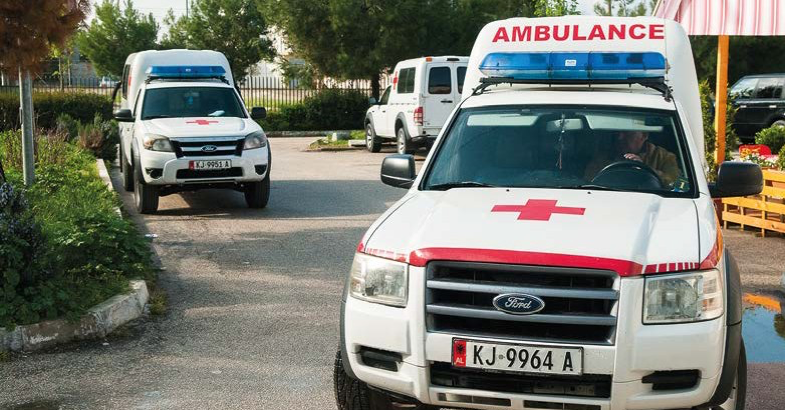
Health Services Transformed: A New Hospital in Coastal Albania
The biggest impact of Kavaja’s new hospital is clearly for its patients. Today, the city’s 120,000 residents benefit from modern healthcare facilities. But before the new hospital building was constructed, people in this coastal, rural area lived with low standards of healthcare, similar to those found across many regions outside of Albania’s capital, Tirana.
The previous building in the city, which is an hour by road from the capital city, could not fully function properly: providing proper treatment and care for patients was very difficult in the 92-bed facility. The building was in a poor state, and the lack of space and protection meant that medical equipment could not be used safely. The new facilities and increase in staff capacity at the new hospital have completely transformed standards for the residents of Kavaja and beyond.
Space to grow in new facilities
In recent decades, Kavaja faced problems similar to many rural regions of Albania: a major population shift to Tirana and other large cities for more economic opportunities. But people do not leave only in search of jobs; people also seek a better quality of life, including services such as healthcare.
To address this, the Government of Albania decided to raise healthcare standards outside of the capital. IsDB, responding to the country’s request, agreed to support the construction of the new hospital in Kavaja in August 2004.
The total cost was US$8.57 million, with IsDB providing US$5.52 million as an ordinary loan, to cover construction costs. Further financing for the medical equipment and furniture was provided by the OPEC Fund for International Development (US$2.41 million), and by the Government of Albania (US$0.64 million) for half of the civil works costs.
In the area where the facilities were needed, setbacks with the land and essential connections required for the hospital delayed construction, but the Kavaja Hospital Project was fully completed in December 2010. And despite the delay, the final project cost was 2 per cent below the estimates at appraisal.
Occupancy at the old hospital in Kavaja ran at just 23 per cent, because people were using the better facilities in Tirana or at the regional hospital in Durrës. By contrast, facilities at the new hospital include two operating theatres (one for general surgery and another for obstetrics and gynaecology) and a polyclinic providing both general and specialist examinations and treatments.
Patient care is transformed
Bardha Ndrea, who is Deputy Director (Finance) at Kavaja hospital, has given 25 years of service and remembers the former facilities.
“Even the rain and humidity were coming into the building. The medical devices were old and used for a very long period. Surgery, intensive care and physiotherapy simply did not exist before.”
She adds that the building had no air conditioning – in a town where temperatures are often around 40 degrees Celsius in the summer months.
Now, patient care has improved beyond recognition. Serving a population of 120,000 local people, the hospital also has the capacity to care for the annual influx of people who come from other parts of Albania and further afield in the summer – an estimated extra 70,000 people. The services are provided free at the point of care for citizens, delivered by Albania’s public health system. Patients who go to the hospital directly without being referred by a family doctor pay less than one euro – 70 cents – for their consultations.
A step change in healthcare
There is no doubt that the healthcare facilities now available to the people of Kavaja have been transformed by the new hospital. There is further capacity to take advantage of the new building to accommodate more services, such as specialised cardiology. But the services already on offer represent a clear improvement compared with the previous facilities, in which surgical operations were not even possible.
The project has also helped Albania with its efforts to develop a network of healthcare services at the district level, rather than just in the capital city. As the government continues to support district hospitals, it is also helping alleviate rural and coastal poverty, and easing the burden on healthcare provision in Tirana. The district hospital in Kavaja is playing its part in this - thanks to the high standard of new facilities.
A first-rate service for Kavaja
The district hospital in Kavaja still faces challenges. It continues to be challenging to attract some of the specialists needed to provide a complete set of healthcare services; Dr Beu would especially like to improve the number of surgical and intensive care specialists employed here.
But despite this, the signs are promising for the future. Fewer patients are having to make the trek to the capital for specialist care, and occupancy in the new building has been growing steadily.
Success factors
- Clear need. There was an acute shortage of healthcare services in rural and coastal Albania. The new Kavaja hospital helps to address this shortfall.
- National relevance. The new hospital supports Albania’s efforts to rebalance its healthcare provision, which previously focused on the capital city and left other areas underserved.
- Further capacity for expansion. The hospital is seeing year-on-year growth in its occupancy. The full potential – the capacity planned in at the project’s conception should be reached within the coming years, supported by government efforts to retain specialist doctors and improve logistics such as emergency dispatch and patient transport.
